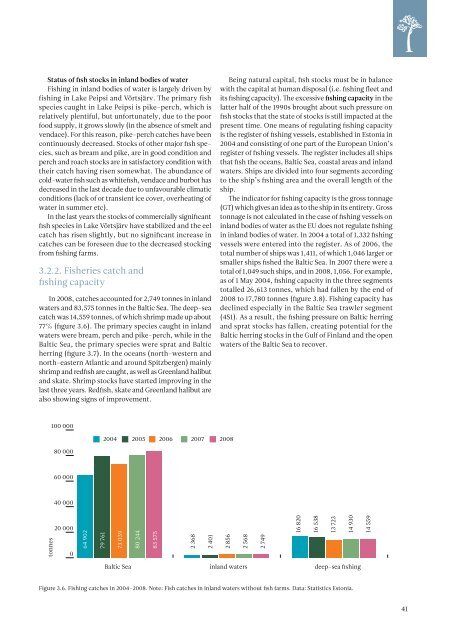ESTONIAN ENVIRONMENTAL REVIEW 2009
ESTONIAN ENVIRONMENTAL REVIEW 2009
ESTONIAN ENVIRONMENTAL REVIEW 2009
Create successful ePaper yourself
Turn your PDF publications into a flip-book with our unique Google optimized e-Paper software.
Status of fish stocks in inland bodies of water<br />
Fishing in inland bodies of water is largely driven by<br />
fishing in Lake Peipsi and Võrtsjärv. The primary fish<br />
species caught in Lake Peipsi is pike-perch, which is<br />
relatively plentiful, but unfortunately, due to the poor<br />
food supply, it grows slowly (in the absence of smelt and<br />
vendace). For this reason, pike-perch catches have been<br />
continuously decreased. Stocks of other major fish species,<br />
such as bream and pike, are in good condition and<br />
perch and roach stocks are in satisfactory condition with<br />
their catch having risen somewhat. The abundance of<br />
cold-water fish such as whitefish, vendace and burbot has<br />
decreased in the last decade due to unfavourable climatic<br />
conditions (lack of or transient ice cover, overheating of<br />
water in summer etc).<br />
In the last years the stocks of commercially significant<br />
fish species in Lake Võrtsjärv have stabilized and the eel<br />
catch has risen slightly, but no significant increase in<br />
catches can be foreseen due to the decreased stocking<br />
from fishing farms.<br />
3.2.2. Fisheries catch and<br />
fishing capacity<br />
In 2008, catches accounted for 2,749 tonnes in inland<br />
waters and 83,575 tonnes in the Baltic Sea. The deep-sea<br />
catch was 14,559 tonnes, of which shrimp made up about<br />
77% (figure 3.6). The primary species caught in inland<br />
waters were bream, perch and pike-perch, while in the<br />
Baltic Sea, the primary species were sprat and Baltic<br />
herring (figure 3.7). In the oceans (north-western and<br />
north-eastern Atlantic and around Spitzbergen) mainly<br />
shrimp and redfish are caught, as well as Greenland halibut<br />
and skate. Shrimp stocks have started improving in the<br />
last three years. Redfish, skate and Greenland halibut are<br />
also showing signs of improvement.<br />
Being natural capital, fish stocks must be in balance<br />
with the capital at human disposal (i.e. fishing fleet and<br />
its fishing capacity). The excessive fishing capacity in the<br />
latter half of the 1990s brought about such pressure on<br />
fish stocks that the state of stocks is still impacted at the<br />
present time. One means of regulating fishing capacity<br />
is the register of fishing vessels, established in Estonia in<br />
2004 and consisting of one part of the European Union’s<br />
register of fishing vessels. The register includes all ships<br />
that fish the oceans, Baltic Sea, coastal areas and inland<br />
waters. Ships are divided into four segments according<br />
to the ship’s fishing area and the overall length of the<br />
ship.<br />
The indicator for fishing capacity is the gross tonnage<br />
(GT) which gives an idea as to the ship in its entirety. Gross<br />
tonnage is not calculated in the case of fishing vessels on<br />
inland bodies of water as the EU does not regulate fishing<br />
in inland bodies of water. In 2004 a total of 1,332 fishing<br />
vessels were entered into the register. As of 2006, the<br />
total number of ships was 1,411, of which 1,046 larger or<br />
smaller ships fished the Baltic Sea. In 2007 there were a<br />
total of 1,049 such ships, and in 2008, 1,056. For example,<br />
as of 1 May 2004, fishing capacity in the three segments<br />
totalled 26,613 tonnes, which had fallen by the end of<br />
2008 to 17,780 tonnes (figure 3.8). Fishing capacity has<br />
declined especially in the Baltic Sea trawler segment<br />
(4S1). As a result, the fishing pressure on Baltic herring<br />
and sprat stocks has fallen, creating potential for the<br />
Baltic herring stocks in the Gulf of Finland and the open<br />
waters of the Baltic Sea to recover.<br />
100 000<br />
2004 2005 2006 2007 2008<br />
80 000<br />
60 000<br />
40 000<br />
tonnes<br />
20 000<br />
0<br />
64 902<br />
79 761<br />
73 039<br />
80 244<br />
83 575<br />
2 368<br />
2 401<br />
2 856<br />
2 568<br />
2 749<br />
16 820<br />
16 538<br />
13 723<br />
14 930<br />
14 559<br />
Baltic Sea<br />
inland waters<br />
deep-sea fishing<br />
Figure 3.6. Fishing catches in 2004–2008. Note: Fish catches in inland waters without fish farms. Data: Statistics Estonia.<br />
41

















